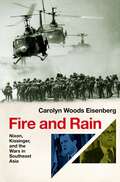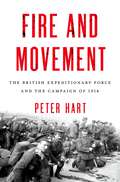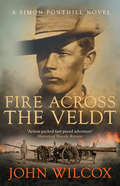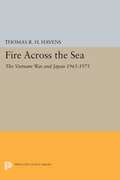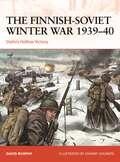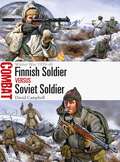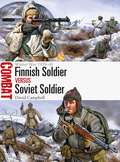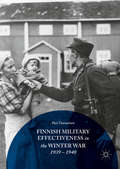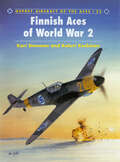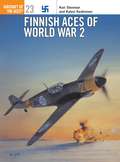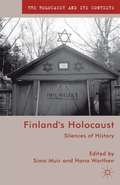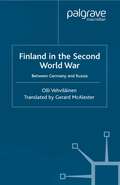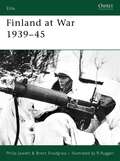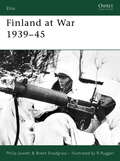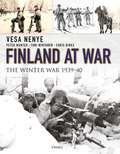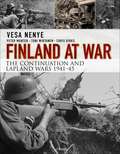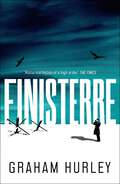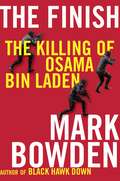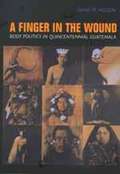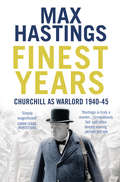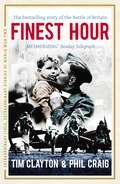- Table View
- List View
Fire and Rain: Nixon, Kissinger, and the Wars in Southeast Asia
by Carolyn Woods EisenbergThis gripping account interweaves Nixon and Kissinger's pursuit of the war in Southeast Asia and their diplomacy with the Soviet Union and China with on-the-ground military events and US domestic reactions to the war conducted in Vietnam, Laos, and Cambodia. Fire and Rain is a compelling, meticulous narrative of the way national security decisions formed at the highest levels of government affect the lives of individuals at home and abroad. By drawing these connections, Carolyn Woods Eisenberg brings to life policy decisions about Vietnam, Laos, and Cambodia, conveying their significance to a new generation of readers. She breaks fresh ground in contextualizing Richard Nixon and Henry Kissinger's decisions within a wider institutional and societal framework. While recognizing the distinctive personalities and ideas of these two men, this study more broadly conveys the competing roles and impact of the professional military, the Congress, and a mobilized peace movement. Drawing upon a vast collection of declassified documents, Eisenberg presents an important re-interpretation of the Nixon Administration's relations with the Soviet Union and China vis a vis the war in Southeast Asia. She argues that in their desperate effort to overcome, or at least overshadow, their failure in Vietnam, Nixon and Kissinger made major concessions to both nations in the field of arms control, their response to the India-Pakistan war, and the diplomacy surrounding Taiwan--much of this secret. Despite policymakers' claims that the Vietnam War was a "national security" necessity that would demonstrate American strength to the communist superpowers and "credibility" to friendly governments, the historical record suggests a different reality. A half-century after the Paris Peace Conference marking the withdrawal of US troops and advisors from Vietnam and foreign troops from Laos and Cambodia, Fire and Rain is a dramatic account of geopolitical decision making, civil society, and the human toll of the war on the people of Southeast Asia.
Fire and Movement: The British Expeditionary Force and the Campaign of 1914
by Peter HartThe dramatic opening weeks of the Great War passed into legend long before the conflict ended. The British Expeditionary Force fought a mesmerizing campaign, outnumbered and outflanked but courageous and skillful, holding the line against impossible odds, sacrificing themselves to stop the last great German offensive of 1914. A remarkable story of high hopes and crushing disappointment, the campaign contains moments of sheer horror and nerve-shattering excitement; pathos and comic relief; occasional cowardice and much selfless courage--all culminating in the climax of the First Battle of Ypres. And yet, as Peter Hart shows in this gripping and revisionary look at the war's first year, for too long the British part in the 1914 campaigns has been veiled in layers of self-congratulatory myth: a tale of poor unprepared Britain, reliant on the peerless class of her regular soldiers to bolster the rabble of the unreliable French Army and defeat the teeming hordes of German troops. But the reality of those early months is in fact far more complex--and ultimately, Hart argues, far more powerful than the standard triumphalist narrative. Fire and Movement places the British role in 1914 into a proper historical context, incorporating the personal experiences of the men who were present on the front lines. The British regulars were indeed skillful soldiers, but as Hart reveals, they also lacked practice in many of the required disciplines of modern warfare, and the inexperience of officers led to severe mistakes. Hart also provides a more accurate portrait of the German Army they faced--not the caricature of hordes of automatons, but the reality of a well-trained and superlatively equipped force that outfought the BEF in the early battles--and allows readers to come to a full appreciation of the role of the French Army, without whom the Marne never would have been won. Ultimately Fire and Movement shows the story of the 1914 campaigns to be an epic tale, and one which needs no embellishment. Through the voices and recollections of the soldiers who were there, Hart strips away the myth to offer a clear-eyed account of the remarkable early days of the Great War.
Fire and Movement: The British Expeditionary Force and the Campaign of 1914
by Peter HartThe dramatic opening weeks of the Great War passed into legend long before the conflict ended. The British Expeditionary Force fought a mesmerizing campaign, outnumbered and outflanked but courageous and skillful, holding the line against impossible odds, sacrificing themselves to stop the last great German offensive of 1914. A remarkable story of high hopes and crushing disappointment, the campaign contains moments of sheer horror and nerve-shattering excitement; pathos and comic relief; occasional cowardice and much selfless courage--all culminating in the climax of the First Battle of Ypres. And yet, as Peter Hart shows in this gripping and revisionary look at the war's first year, for too long the British part in the 1914 campaigns has been veiled in layers of self-congratulatory myth: a tale of poor unprepared Britain, reliant on the peerless class of her regular soldiers to bolster the rabble of the unreliable French Army and defeat the teeming hordes of German troops. But the reality of those early months is in fact far more complex--and ultimately, Hart argues, far more powerful than the standard triumphalist narrative. Fire and Movement places the British role in 1914 into a proper historical context, incorporating the personal experiences of the men who were present on the front lines. The British regulars were indeed skillful soldiers, but as Hart reveals, they also lacked practice in many of the required disciplines of modern warfare, and the inexperience of officers led to severe mistakes. Hart also provides a more accurate portrait of the German Army they faced--not the caricature of hordes of automatons, but the reality of a well-trained and superlatively equipped force that outfought the BEF in the early battles--and allows readers to come to a full appreciation of the role of the French Army, without whom the Marne never would have been won. Ultimately Fire and Movement shows the story of the 1914 campaigns to be an epic tale, and one which needs no embellishment. Through the voices and recollections of the soldiers who were there, Hart strips away the myth to offer a clear-eyed account of the remarkable early days of the Great War.
Fire Across the Veldt (Simon Fonthill #9)
by John WilcoxSouth Africa, 1900. The bloody conflict between the forces of the British Empire and the Boer farmers seemed at last to have ended in victory for Queen Victoria’s soldiers, with the Boer capitals taken and occupied. But fast-riding Boer commandos have emerged to introduce a new type of warfare – hit-and-run guerrilla tactics, fought across the veldt of South Africa and leaving the British ‘Khakis’ plodding and bruised in their wake.To counter these strikes, the British General Kitchener persuades Simon Fonthill, fresh from his triumphs in China’s Boxer Rebellion, to divert to Cape Town and fight the Boers at their own game. So Fonthill, with his old comrade 352 Jenkins as his Regimental Sergeant Major, finds himself reinstated in the British Army as the colonel of his own cavalry unit.Can the two of them adapt to regular soldiering again – and will they be able to catch and pin down those elusive Boer Generals, Louis Botha and Christiaan de Wet? And can Simon’s wife, Alice, reporting on the war for the MorningPost, extricate herself from her own problems in South Africa?
Fire Across the Sea: The Vietnam War and Japan 1965-1975
by Thomas R.H. HavensProfessor Havens analyzes the efforts of Japanese antiwar organizations to portray the war as much more than a fire across the sea" and to create new forms of activism in a country where individuals have traditionally left public issues to the authorities. This path-breaking study examines not only the methods of the protesters but the tightrope dance performed by Japanese officials forced to balance outspoken antiwar sentiment with treaty obligations to the U.S.Originally published in 1987.The Princeton Legacy Library uses the latest print-on-demand technology to again make available previously out-of-print books from the distinguished backlist of Princeton University Press. These editions preserve the original texts of these important books while presenting them in durable paperback and hardcover editions. The goal of the Princeton Legacy Library is to vastly increase access to the rich scholarly heritage found in the thousands of books published by Princeton University Press since its founding in 1905.
The Finnish-Soviet Winter War 1939–40: Stalin's Hollow Victory (Campaign)
by David MurphyThis informative study explores the Soviet invasion of Finland, detailing the events of the Winter War of November 1939 to March 1940. The invasion was expected to be swift and decisive, however, the fighting qualities of the Finnish Army blunted the Soviet advance and inflicted high numbers of casualties. A combination of difficulties caused by the weather, the terrain, the Mannerheim Line defences and Finnish tactics resulted in a fascinating David vs Goliath type struggle.On 23 August 1939, a secret protocol was appended to the German–Soviet Non-Aggression Pact; as part of this, Finland was assigned to the Soviet sphere of influence. On 30 November that year, in an effort to protect against renewed German aggression in the East, the Soviet Union attacked Finland, beginning what became known as the Finnish-Soviet Winter War. This long-awaited addition to the Campaign series explores the events of the war of November 1939 to March 1940. Set against the background of the developing global conflict, the conflict saw the Finnish Army thwart the plans of the sizeable Soviet forces assembled against it, before finally being forced to concede. The major battles of the war, which took place in harsh winter conditions, are covered in detail, including the Mannerheim Line, the fighting in Ladoga Karelia and Kollaa, and the clashes in Finnish Lapland.
The Finnish-Soviet Winter War 1939–40: Stalin's Hollow Victory (Campaign #367)
by David MurphyThis informative study explores the Soviet invasion of Finland, detailing the events of the Winter War of November 1939 to March 1940. The invasion was expected to be swift and decisive, however, the fighting qualities of the Finnish Army blunted the Soviet advance and inflicted high numbers of casualties. A combination of difficulties caused by the weather, the terrain, the Mannerheim Line defences and Finnish tactics resulted in a fascinating David vs Goliath type struggle.On 23 August 1939, a secret protocol was appended to the German–Soviet Non-Aggression Pact; as part of this, Finland was assigned to the Soviet sphere of influence. On 30 November that year, in an effort to protect against renewed German aggression in the East, the Soviet Union attacked Finland, beginning what became known as the Finnish-Soviet Winter War. This long-awaited addition to the Campaign series explores the events of the war of November 1939 to March 1940. Set against the background of the developing global conflict, the conflict saw the Finnish Army thwart the plans of the sizeable Soviet forces assembled against it, before finally being forced to concede. The major battles of the war, which took place in harsh winter conditions, are covered in detail, including the Mannerheim Line, the fighting in Ladoga Karelia and Kollaa, and the clashes in Finnish Lapland.
Finnish Soldier vs Soviet Soldier: Winter War 1939–40 (Combat #21)
by David CampbellThe Winter War was supposed to be a quick and easy conflict; instead it proved to be a bitter war that destroyed the international reputation of the Soviet Red Army. The diminutive Finnish force was desperately outnumbered by almost half a million Russian troops, but rather than sweeping across their neighbours the Soviet troops stumbled blindly, constantly wrong-footed and then bloodied by their seemingly insignificant foe. Drawing on a wide range of sources this study looks at three key battles, drawing a stark contrast between the poorly prepared Russian troops and the Finns, who made excellent use of terrain and innovative guerrilla tactics as they defended their homeland.Detailed maps and specially commissioned artwork highlight key moments in the Winter War, a David-and-Goliath conflict that saw the Soviet Union suffer horrendous losses as they tried to recover from each disastrous defeat.
Finnish Soldier vs Soviet Soldier: Winter War 1939–40 (Combat #21)
by Johnny Shumate David CampbellThe Winter War was supposed to be a quick and easy conflict; instead it proved to be a bitter war that destroyed the international reputation of the Soviet Red Army. The diminutive Finnish force was desperately outnumbered by almost half a million Russian troops, but rather than sweeping across their neighbours the Soviet troops stumbled blindly, constantly wrong-footed and then bloodied by their seemingly insignificant foe. Drawing on a wide range of sources this study looks at three key battles, drawing a stark contrast between the poorly prepared Russian troops and the Finns, who made excellent use of terrain and innovative guerrilla tactics as they defended their homeland.Detailed maps and specially commissioned artwork highlight key moments in the Winter War, a David-and-Goliath conflict that saw the Soviet Union suffer horrendous losses as they tried to recover from each disastrous defeat.
Finnish Military Effectiveness in the Winter War, 1939-1940
by Pasi TuunainenThis book analyzes the multi-faceted phenomenon of Finnish military effectiveness in the Winter War (1939–40). Drawing on a wide array of primary and secondary sources, Pasi Tuunainen shows how by focusing on their own strengths and pitting these against the weaknesses of their adversary, the Finns were able to inflict heavy casualties on the Red Army whilst minimizing their own losses. The Finns were able to use their resources for effective operational purposes, and perform almost to their full potential. The Finnish small-unit tactics utilized the terrain and Arctic conditions for which they had prepared themselves, as well as forming cohesive units of well-motivated and qualitatively better professional leaders and citizen soldiers who could innovate and adapt. The Finnish Army had highly effective logistics, support and supply systems that kept the troops fighting.
Finnish Aces of World War 2 (Aircraft of the Aces #23)
by Kari StenmanAlways outnumbered by their Soviet counterparts, the small band of Finnish fighter pilots who defended their Scandinavian homeland from the 'communist hordes' in three separate wars between 1939 and 1945 amassed scores only bettered by the Luftwaffe's Jagdflieger. Initially equipped with a motley collection of biplane and monoplane fighters garnered from sources across the globe, the Finnish Air Force was thrust into combat in November 1939. Given little chance against the massive Soviet force, the Finnish fighter pilots confounded the sceptics and decimated the attacking fighter and bomber formations, prompting the Russians to call a halt in March 1940. This scenario was repeated in 1941, and by 1943 the Finns had become uneasy allies with the Germans. Complete with first-hand accounts and detailed colour illustrations, this book profiles aces like Juutilainen and Wind, who proved unbeatable in the final months of conflict.
Finnish Aces of World War 2 (Aircraft of the Aces)
by Kari Stenman Mark StylingAlways outnumbered by their Soviet counterparts, the small band of Finnish fighter pilots who defended their Scandinavian homeland from the 'communist hordes' in three separate wars between 1939 and 1945 amassed scores only bettered by the Luftwaffe's Jagdflieger. Initially equipped with a motley collection of biplane and monoplane fighters garnered from sources across the globe, the Finnish Air Force was thrust into combat in November 1939. Given little chance against the massive Soviet force, the Finnish fighter pilots confounded the sceptics and decimated the attacking fighter and bomber formations, prompting the Russians to call a halt in March 1940. This scenario was repeated in 1941, and by 1943 the Finns had become uneasy allies with the Germans. Complete with first-hand accounts and detailed colour illustrations, this book profiles aces like Juutilainen and Wind, who proved unbeatable in the final months of conflict.
Finland's Holocaust: Silences of History (The Holocaust and its Contexts)
by Simo Muir and Hana WorthenFinland's Holocaust considers antisemitism and the figure of the Holocaust in today's Finland. Taking up a range of issues - from cultural history, folklore, and sports, to the interpretation of military and national history - this collection examines how the writing of history has engaged and evaded the figure of the Holocaust.
Finland in the Second World War: Between Germany and Russia
by Olli VehviläinenThis book describes the struggle for power between two totalitarian dictatorships in the north of Europe and the battle for survival of a small nation caught between them. In the Winter War of 1939-1940 Finland successfully fought off a Soviet invasion. Then, with none to turn to but Germany, it became the only democratic state on the Axis side. Ultimately, it succeeded in extricating itself from the war and, despite the shadow of Russia looming over it, averted a Communist takeover.
Finland at War 1939–45 (Elite #141)
by Raffaele Ruggeri Philip Jowett Brent SnodgrassIn the face of Soviet invasion in 1939–40, and once again in 1941–44, the armies raised by Finland – a tiny nation of only 4 million people astonished the world by their effective resistance. At the end of both these campaigns – the Winter War, and the Continuation War – the fiercely patriotic defiance of vastly stronger Soviet forces by Marshal Mannerheim's soldiers won their country a unique prize: although forced to accept harsh terms, Finland was never occupied by the Red Army, and retained its independence. This book explains and illustrates, for the first time in English, the organization, uniforms, equipment and tactics of Finland's defenders.
Finland at War 1939–45 (Elite #141)
by Raffaele Ruggeri Philip Jowett Brent SnodgrassIn the face of Soviet invasion in 1939–40, and once again in 1941–44, the armies raised by Finland – a tiny nation of only 4 million people astonished the world by their effective resistance. At the end of both these campaigns – the Winter War, and the Continuation War – the fiercely patriotic defiance of vastly stronger Soviet forces by Marshal Mannerheim's soldiers won their country a unique prize: although forced to accept harsh terms, Finland was never occupied by the Red Army, and retained its independence. This book explains and illustrates, for the first time in English, the organization, uniforms, equipment and tactics of Finland's defenders.
Finland at War: The Winter War 1939–40 (General Military Ser. #3)
by Vesa Nenye Peter Munter Toni Wirtanen Chris BirksThe story of the 'Winter War' between Finland and Soviet Russia is a dramatic David versus Goliath encounter. When close to half a million Soviet troops poured into Finland in 1939 it was expected that Finnish defences would collapse in a matter of weeks. But they held firm. The Finns not only survived the initial attacks but succeeded in inflicting devastating casualties before superior Russian numbers eventually forced a peace settlement. This is a rigorously detailed and utterly compelling guide to Finland's vital, but almost forgotten role in the cataclysmic World War II. It reveals the untold story of iron determination, unparalleled skill and utter mastery of winter warfare that characterised Finland's fight for survival on the hellish Eastern Front. Now publishing in paperback, Finland at War: the Winter War 1939–40 is the premiere English-language history of the fighting performance of the Finns, drawing on first-hand accounts and rare photographs to explain just how they were able to perform military feats that nearly defy belief.
Finland at War: The Continuation and Lapland Wars 1941–45 (General Military Ser. #3)
by Vesa Nenye Peter Munter Toni Wirtanen Chris BirksIn the aftermath of the Winter War Finland found itself drawing ever closer to Nazi Germany and eventually took part in Operation Barbarossa in 1941. For the Finns this was a chance to right the wrongs of the Winter War, and having reached suitable defensive positions, the army was ordered to halt. Years of uneasy trench warfare followed, known as the Continuation War, during which Finland desperately sought a way out, German dreams of victory were dashed and the Soviet Union built the strongest army in the world. In the summer of 1944, the whole might of the Red Army was launched against the Finnish defences on the narrow Karelian Isthmus. Over several weeks of fierce fighting, the Finns managed to halt the Soviet assault. With Stalin forced to divert his armies to the race to Berlin an armistice agreement was reached, the harsh terms of which forced the Finns to take on their erstwhile German allies in Lapland. Featuring never-before-seen photographs and first-hand accounts, this second volume of a two-part study details the high price Finland had to pay to retain its independence and freedom.
Finland at War: The Winter War 1939–40
by Vesa Nenye Peter Munter Toni Wirtanen Chris BirksThe story of the 'Winter War' between Finland and Soviet Russia is a dramatic David versus Goliath encounter. When close to half a million Soviet troops poured into Finland in 1939 it was expected that Finnish defences would collapse in a matter of weeks. But they held firm. The Finns not only survived the initial attacks but succeeded in inflicting devastating casualties before superior Russian numbers eventually forced a peace settlement. This is a rigorously detailed and utterly compelling guide to Finland's vital, but almost forgotten role in the cataclysmic World War II. It reveals the untold story of iron determination, unparalleled skill and utter mastery of winter warfare that characterised Finland's fight for survival on the hellish Eastern Front. Now publishing in paperback, Finland at War: the Winter War 1939–40 is the premiere English-language history of the fighting performance of the Finns, drawing on first-hand accounts and rare photographs to explain just how they were able to perform military feats that nearly defy belief.
Finland at War: The Continuation and Lapland Wars 1941–45
by Vesa Nenye Peter Munter Toni Wirtanen Chris BirksIn the aftermath of the Winter War Finland found itself drawing ever closer to Nazi Germany and eventually took part in Operation Barbarossa in 1941. For the Finns this was a chance to right the wrongs of the Winter War, and having reached suitable defensive positions, the army was ordered to halt. Years of uneasy trench warfare followed, known as the Continuation War, during which Finland desperately sought a way out, German dreams of victory were dashed and the Soviet Union built the strongest army in the world. In the summer of 1944, the whole might of the Red Army was launched against the Finnish defences on the narrow Karelian Isthmus. Over several weeks of fierce fighting, the Finns managed to halt the Soviet assault. With Stalin forced to divert his armies to the race to Berlin an armistice agreement was reached, the harsh terms of which forced the Finns to take on their erstwhile German allies in Lapland. Featuring never-before-seen photographs and first-hand accounts, this second volume of a two-part study details the high price Finland had to pay to retain its independence and freedom.
Finisterre (Spoils of War #1)
by Graham Hurley'Historical fiction of a high order' The Times Germany, October 1944: Dozens of cities lie in ruins. Enemy armies are at the gates. For the Thousand Year Reich, time is running out.Desperate to avoid the humiliation of unconditional surrender, German intelligence launch Operation Finisterre – a last-ditch plan to enable Hitler to deny the savage logic of a war on two fronts and bluff his way to the negotiating table.Success depends on two individuals: Stefan Portisch, a German naval officer washed ashore on the coast of Spain after the loss of his U-boat, and Hector Gomez, an ex-FBI detective, planted by Director J. Edgar Hoover in the middle of the most secret place on earth: the American atomic bomb complex. Both men will find themselves fighting for survival as Operation Finisterre plays itself out.Finisterre is part of the SPOILS OF WAR Collection, a thrilling, beguiling blend of fact and fiction born of some of the most tragic, suspenseful, and action-packed events of World War II. From the mind of highly acclaimed thriller author GRAHAM HURLEY, this blockbuster non-chronological collection allows the reader to explore Hurley's masterful storytelling in any order, with compelling recurring characters whose fragmented lives mirror the war that shattered the globe.
The Finish: The killing of Osama bin Laden
by Mark Bowden"There wasn't a meeting when someone didn't mention Black Hawk Down ." - A senior Obama administration official, as quoted in The New York Times, 02/05/2011 From Mark Bowden, internationally bestselling and acclaimed author of Black Hawk Down and the preeminent chronicler of the actions of the US military and special forces writing today, comes an intensely gripping account of the hunt for and elimination of Osama bin Laden. With unprecedented access to key sources and his great gift for storytelling, Bowden takes us inside the rooms where decisions were made and where the action unfolded. The story focuses on bin Laden, who maintained a steady stream of despairing correspondence in hiding in the year before his death, and on President Obama, perceived by many as an anti-war candidate because of his opposition to the Iraq War, whose evolving views and enormous responsibilities have turned him into one of the most determined warriors to ever inhabit the White House. It details the rapid evolution of war-fighting methods over the last decade, as American special forces and intelligence agencies have adapted to fight non-state enemies like Al-Qaeda, and how they came together seamlessly in May 2011 to kill the world's most notorious terrorist. Tracing the operation in blow-by-blow detail, Bowden's book is an unrivaled account of the most high-profile special forces operation ever to have been undertaken, and a page-turning narrative of how the man behind 9/11 was finally brought to justice.
A Finger in the Wound: Body Politics in Quincentennial Guatemala (PDF)
by Diane M. NelsonMany Guatemalans speak of Mayan indigenous organizing as "a finger in the wound." Diane Nelson explores the implications of this painfully graphic metaphor in her far-reaching study of the civil war and its aftermath. Why use a body metaphor? What body is wounded, and how does it react to apparent further torture? If this is the condition of the body politic, how do human bodies relate to it—those literally wounded in thirty-five years of war and those locked in the equivocal embrace of sexual conquest, domestic labor, mestizaje, and social change movements? Supported by three and a half years of fieldwork since 1985, Nelson addresses these questions—along with the jokes, ambivalences, and structures of desire that surround them—in both concrete and theoretical terms. She explores the relations among Mayan cultural rights activists, ladino (nonindigenous) Guatemalans, the state as a site of struggle, and transnational forces including Nobel Peace Prizes, UN Conventions, neo-liberal economics, global TV, and gringo anthropologists. Along with indigenous claims and their effect on current attempts at reconstituting civilian authority after decades of military rule, Nelson investigates the notion of Quincentennial Guatemala, which has given focus to the overarching question of Mayan—and Guatemalan—identity. Her work draws from political economy, cultural studies, and psychoanalysis, and has special relevance to ongoing discussions of power, hegemony, and the production of subject positions, as well as gender issues and histories of violence as they relate to postcolonial nation-state formation.
Finest Years: Churchill As Warlord, 1940-1945
by Max HastingsPre-eminent military historian Max Hastings presents Winston Churchill as he has never been seen before.
Finest Hour: The bestselling story of the Battle of Britain (Extraordinary Lives, Extraordinary Stories of World War Two)
by Phil Craig Tim ClaytonSeventy years ago, Europe lay at Hitler's feet. Britain faced its darkest hour - outnumbered and friendless as the German army continued its advance. Defeat or capitulation seemed inevitable. But instead a legend was born. Taking its readers on a breathtaking journey from open lifeboats in Atlantic gales to the cockpits of burning fighter-planes, and through cities devastated by the Blitz, FINEST HOUR recreates the terror, the tragedy and the triumph of the Battle of Britain. This powerful account of the events of 1940 is told through the voices, diaries, letters and memoirs of the men and women who lived, loved, fought and died during this terrible yet inspiring year. FINEST HOUR blends original historical research with the experiences of ordinary people in desperate times. Cutting through the nostalgic haze, this book enables readers to experience a time - still within living memory - when a nations's darkest hour became its finest.
